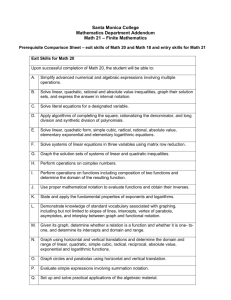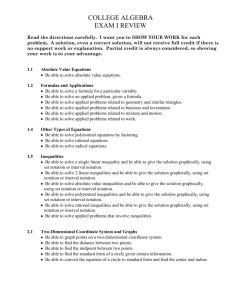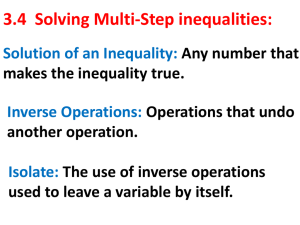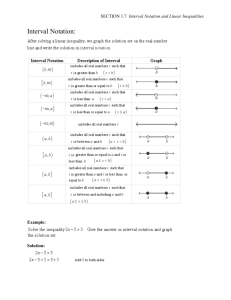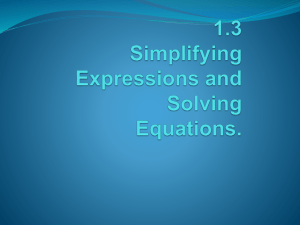Midterm Review
advertisement
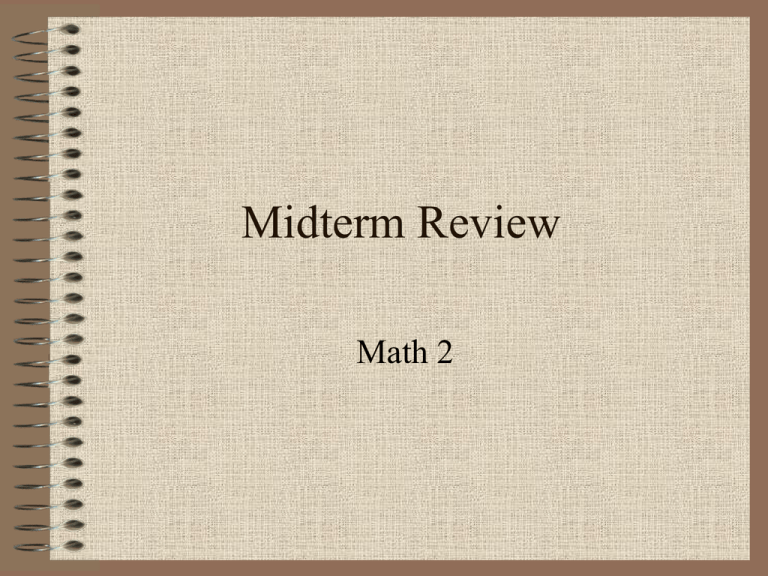
Midterm Review
Math 2
Topics
Equations
Inequalities
Lines
Systems of Linear Equations in Two Variables
Factoring
Laws of Exponents
Functions
Equations
1. You may add or subtract the same expression
on both sides of an equation.
2. You may multiply or divide both sides of an
equation by the same non-zero expression.
3. You may replace any expression by an
equivalent expression.
Linear
Absolute Value
Polynomial
Inequalities
1.
2.
3.
4.
You may add or subtract the same expression on both
sides of an equation.
You may multiply or divide both sides of an equation
by the same positive expression.
You may multiply or divide both sides of an equation
by the same negative expression if you switch the
sense of the inequality.
You may replace any expression by an equivalent
expression.
Interval Notation and Graphing Solution Set
Types of Inequalities
Lines
General linear equation: ax + by = c
Slope-intercept equation: y = mx + b
Point-slope equation: y-y1= m(x – x1)
rise y2 y1
Slope:
m
run
x 2 x1
Parallel lines have the same slope.
Perpendicular lines have slopes that are
opposite reciprocals.
Vertical lines have no slope.
Systems of Equations
Two equations in two Variables
• Represent two lines
• Solution represents the intersection of the lines
• May have 0, 1, or infinitely many ordered pairs in the
solution set
Three equations in Three Variables
• Represents three planes
• Solve by reducing to a system of two equations in two
variables.
Factoring
Greatest Common Factor
Special Binomial Forms
Trinomial Forms
Polynomials with Four Terms
Laws of Exponents
1.
2.
3.
4.
5.
am an = am+n
am /an = am-n
(am)n = amn
(ab)m = am bm
(a/b)m = am / bm
Definitions: Let a 0 then
a0 = 1 and a-n = 1/an
Functions
A rule that assigns to each element of the
domain a unique element of the range.
A set of ordered pairs (x,y) such that each x
corresponds to one and only one y.
The graph of a function intersects any
vertical line in at most one point.
f(x) notation.
Types of Inequalities
1. Linear: Isolate the variable
2. Intersection or overlap when the inequalities
are joined by “and”
3. Union, include both sets when the inequalities
are joined by “or”
4. Absolute Value: Two inequalities using “and”
or “or”
Linear equation
3(x + 5) – 7 = 4x – (x+3)
3x + 15 – 7 = 4x – x – 3
3x + 8 = 3x – 3
8=–3
No Solution
Absolute Value Equation
3 |2x – 5| +7 = 28
3 |2x – 5| = 21
|2x – 5| = 7
Interpret: 2x – 5 = 7 or 2x – 5 = – 7
2x = 12 or 2x = – 2
x=6 or x = – 1
{– 1, 6}
Polynomial Equation
2x2 + x = 10
2x2 + x – 10 = 0
(2x + 5)(x – 2) = 0
2x + 5 = 0 or x – 2 = 0
2x = – 5 or x = 2
x = – 5/2 or x = 2
{– 5/2, 2}
Linear Inequalities
•
•
•
•
•
3(x + 2) < 2(4x – 7) distribute
3x + 6 < 8x –14
subtract 8x and 6
-5x < -20
divide by –5 and flip
x>4
solution
(4, ) interval notation and graph
0
4
Absolute Value Inequality “and”
•
•
•
•
•
•
|3x – 5| 10
3x – 5 10 and 3x – 5 -10
Can be written –10 3x – 5 10
-5 3x 15
-5/3 x 5
[-5/3, 5]
-5/3
0
5
Absolute Value Inequality “or”
•
•
•
•
•
|2x – 5| > 3
2x – 5 > 3 or 2x – 5 < -3
2x > 8
or 2x < 2
x>4
or x < 1
Interval notation: (,1) (8, )
0 1
4
Interval Notation and Graphing
• Interval Notation: (-3,5]
• Graph:
-3
5
• < or > don’t include the value, parenthesis
use open circle on graph
• or include the value, square bracket
use closed circle on graph
• Always use parentheses with infinity
(, ) or (, 4]or (3, )
Solving Systems of Equations
Substitution
Elimination
Cramer’s Rule
Substitution
1. Solve one of the equations for one of the
variables. Avoid introducing fractions if
possible.
2. Substitute this expression into the other
equation.
3. Solve this equation in a single variable.
4. Use the substitution equation to find the value
of the other variable in the ordered pair.
5. Example
Elimination
1. Multiply one or both equations by the
appropriate numbers so that one of the
variables has coefficients that are opposites.
2. Add the equations together to eliminate one
variable.
3. Solve this equation in a single variable.
4. Use either equation to find the other value of
the variable in the ordered pair.
5. Example
Cramer’s Rule
The value for each variable is the ratio of
two determinants.
x = Dx / D
y = Dy / D
If D = 0 and Dx = 0 the system is
dependent and there are infinitely many
solutions.
If D = 0 and Dx 0 the system is
inconsistent and there are no solutions.
Example of Substitution
The system:
1.
2.
3.
4.
5.
2x + y = 7
3x + 5y = 7
Solve for y in first equation: y = 7 – 2x
Substitute: 3x + 5
=7
Solve this equation: 3x + 35 – 10x = 7
-7x + 35 = 7
-7x = -28
x=4
Use the substitution equation: y = 7 – 2
Solution: (4, -1)
= -1
Example of Elimination
The system:
2x + 3y = 13
3x + 2y = 12
1. -2(2x + 3y) = 13(-2)
-4x – 6y = -26
3(3x + 2y) = 12(3)
9x + 6y = 36
5x
= 10
2. x = 2
2(2) + 3y =13
4 + 3y = 13
3y = 9 so y = 3
3. Solution: (2,3)
Determinants
The determinant is a number that we get
from four numbers arranged in two rows
with two numbers in each row.
Given the system: ax + by =c
dx + ey =f
a b
c b
a c
D
, Dx
and Dy
d e
f e
d f
Example
Example of Cramer’s Rule
3x +4y = 2
5x – 2y = 7
D = 3(-2) – 5(4) = -6 – 20 = -26
Dx = 2(-2) – 7(4) = -4 – 28 = -32
Dy = 3(7) – 5(2) = 21 – 10 = 11
x = -32/-26 = 16/13
y = 11/-26
Greatest Common Factor
For each variable look at the value of its
exponent in each term.
Use the lowest value.
Binomials
a2 – b2 =(a + b)(a – b)
a3 – b3 =(a – b)(a2 + ab + b2)
a3 + b3 =(a + b)(a2 – ab + b2)
CAUTION: THESE DO NOT FACTOR
a2 + b 2
a2 + ab + b2
a2 – ab + b2
Trinomials
x2 + 2xy + y2 = (x + y)2
x2 – 2xy + y2 = (x – y)2
x2 + bx + c = (x + r)(x + s)
Where c = rs and b = r + s
ax2 + bx + c = ax2 + rx + sx + c then group
Where ac = rs and b = r + s
Example
Example of ac Method
18x2 – 9x – 20
Find factors of ac = -360 whose sum is – 9
They are 15 and –24
18x2 + 15x – 24x – 20
(18x2 + 15x) – (24x + 20)
3x(6x + 5) – 4(6x + 5)
(3x – 4)(6x + 5)
Tetranomial
ab +2b – 3a – 6
(ab +2b) – (3a + 6)
b(a + 2) – 3(a + 2)
(b – 3)(a + 2)
Domain
The set of all inputs to the function.
Since this variable is usually called x, the
domain is the set of all values for x.
Range
The set of all outputs of the function.
Since this variable is usually called y, the
range is the set of all values for y.
f(x) Notation
f(x) = 3x – 7
x is the input and f(x) is the output.
3x – 7 is the rule.
Input 2
f(2) = 3(2) – 7 = –1 is output.
(2, –1) corresponds to a point on the graph of this
linear function.
More
Graph of a Function
The set of all points corresponding to the
ordered pairs (x,f(x)) is the graph of the
function, i.e. let y = f(x).
If a vertical line intersects the graph in more
than one point then it is not the graph of
function.
More Function Notation
Let f(x) = x2 – 2x
f( ) = (
)2 – 2(
)
Find f(x – 3)
f(x – 3) = (x – 3)2 – 2(x – 3)
= x2 – 6x + 9 – 2x + 6
= x2 – 8x + 15
The End
Relax.
Remember your Picture ID.
Sleep well the night before the exam.
And most important of all…
relax.

